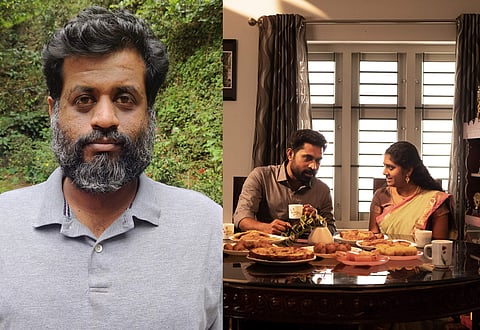Dismantling Conventions: Jeo Baby and The Great Indian Kitchen
These days, when a film directly goes for an OTT release, its quality is brought into question. Of all the Indian films which premiered digitally so far, only a few have stood out. Jeo Baby's The Great Indian Kitchen is one of them. It is, perhaps, the most impactful of all the direct OTT releases in Malayalam so far. Nobody expected such a small film to cause the kind of sensation it has. Aside from a few in the industry, nobody knew of its existence. Besides, nobody had heard of the platform it was premiering on - NeeStream, a recently launched service - until the film's release.
But after the preview screening a day before the launch, word slowly got out that Jeo has made an amazing film that would get both Malayalis and non-Malayalis talking. When the film finally began streaming, the reception was unprecedented. Neither Jeo nor the NeeStream team saw it coming. The platform crashed on the first few days. After many new subscribers complained, the team immediately got to work. In the middle of this, something interesting happened. Some of the frustrated viewers who resorted to piracy sites were so moved by the film that they offered to pay the makers the online ticket price.
If there is one thing that everyone saw coming, it was the backlash from the very people the film took to task. It arrived soon enough - Jeo's social media page flooded with all kinds of vile abuses - but the voices of the film's supporters, especially the female viewers, were large and strong enough to drown out the voices of the offended parties.
Since the release, Jeo's phone has been ringing non-stop as many interview requests bombard him. This conversation happened while he was on the move, after he had just gotten out of one programme and was proceeding to another. However, he found time to speak at length about what compelled him to make the film in which he dismantled both archaic patriarchal conventions and storytelling conventions.
For Jeo, The Great Indian Kitchen, with its minimalist structure, is a significant departure from his earlier films which were quite talky. For this one, he went back to the very roots of filmmaking. "There was a conscious effort to do something completely different from my last three films. We realised that only if we put in a tremendous amount of effort to achieve it would our work stand out, at least to a certain degree," he says. "Our subject and its ideology lent itself well to the narrative format we had in mind - something not too talky and told largely through images."
The screenplay was mostly improvised - Jeo didn't find the need to write all the dialogues. The situations, however, were mentioned. The actors did the rest. The script, Jeo says, would be understood only by him. Some of the film's strongest scenes include the wife (played by a brilliant Nimisha Sajayan) telling her husband (an equally splendid Suraj Venjaramoodu) about the lack of foreplay in their bedroom. In another scene, the husband demands an apology from her for making him feel bad earlier.
"I just wrote that Suraj is making her say sorry. Everything else - the lines, their gestures, and so on - were the contributions of Suraj and Nimisha. I never interfered in their process. When I narrated the story, they understood what details had to be there. For the dialogue delivery, I already had an idea of the duration of each gap between each line. When it comes out through the actors, it gets more fine-tuned," explains Jeo.
Despite the couple's interactions getting increasingly tense as the film progresses, there is not one moment of damaging physical violence. Jeo wanted the damage to be psychological. "I drew from several real-life instances where a person uses words to subdue or 'kill' someone. This happens in every household," says Jeo, adding that he spoke to his wife, other women in his family, and his female friends for inputs. But he also looked within - not just for Suraj's character but also Nimisha's. "Every man has a certain degree of ego. I have too. For Suraj's character, I applied some of my traits - that is, how I used to be a few years ago. By this, I'm not implying that I have turned into a perfect human being now. What I mean is the film connected to everyone because everything in it came from a personal space."
So where did the triggers originate? "When we got married, we had a plan to share the kitchen work. Now, it's easy to make that decision but harder to implement it. My experience in the kitchen was worse than Nimisha's. I felt like I was in some prison. There are two problems here. If you make such a decision, failing to keep your word will lead to much embarrassment. And it was difficult to change my mind because my better half had other responsibilities to handle - her studies and whatnot. So this got me very frustrated. I discussed the experience with other women, including my sisters. They all had a lot to say about this. What you see in the film is just a lighter version. If we had included every single issue, the film would've been much longer."
Speaking of which, Jeo had also pulled off in The Great Indian Kitchen what most Indian filmmakers fail to achieve while making a female-empowerment film - the coherent placement of several issues without making it seem crowded or forced. "Our idea was to concentrate on a particular family's kitchen. And we kept on working and working on the idea for three years until we hit a roadblock which made it difficult to move further," he recalls. Then, the Supreme Court verdict of 2018 (which allowed women of all age groups to enter the Sabarimala Temple) happened. It opened up a new narrative path for Jeo. "It tied the kitchen, women's lives, and their freedom together," he says.
Jeo brought in his frequent collaborator, cinematographer Salu K Thomas, to help achieve his vision. Some audio-visual choices, such as the multi-generation photographs on the wall and the accompanying sounds, happened only a few days into filming. "That particular moment, for instance, was not part of the production design," reveals Jeo. "It was something I noticed in that house and told Salu we should use it. You see, this is the advantage of not having a locked screenplay." A discussion with editor Francis Louis resulted in the film's tight but effective 100-min duration.
Before finding a home on NeeStream, the film was pitched to all the leading Indian OTT giants but met with rejection. Jeo still has no clue why. "We asked them. No answer," he concludes.

